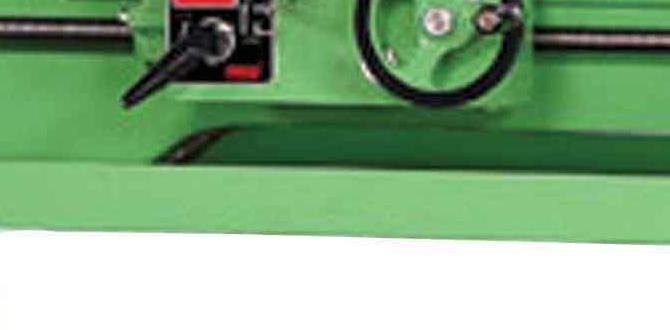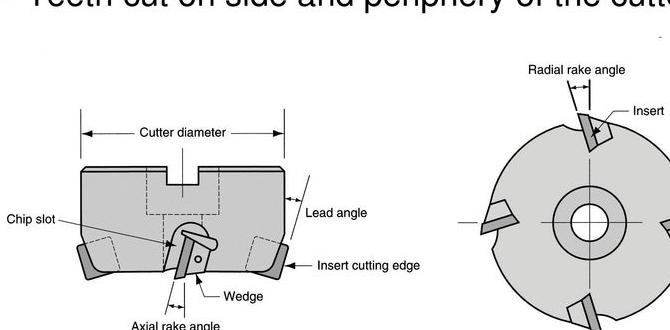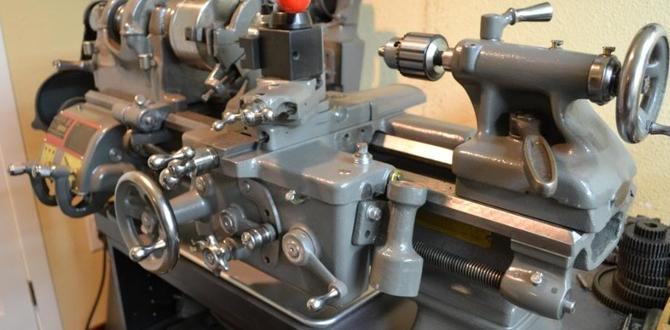Get started with DIY wood lathe duplicator plans! This guide offers free or affordable PDF designs for building your own wood lathe duplicator. Learn how it works, what you’ll need, and how to assemble it for consistent woodturning projects. Perfect for hobbyists seeking repeatable turned parts.
Ever found yourself wishing you could perfectly replicate a turned wooden part? Maybe you need a dozen identical table legs, or perhaps you’re making a set of matching finials. Doing this by hand on a wood lathe can be incredibly challenging, leading to frustration and inconsistent results. But what if you could build a simple device that helps your lathe do the hard work for you? That’s where a wood lathe duplicator comes in! We’re going to explore how you can build one yourself using readily available DIY wood lathe duplicator plans PDF documents. It’s a fantastic project that can save you time and improve the precision of your woodworking.
What Exactly is a Wood Lathe Duplicator?
A wood lathe duplicator is a mechanical attachment that mounts to your lathe. Its primary function is to guide your cutting tool along a pre-made template, allowing you to duplicate the shape of that template onto a new piece of wood. Think of it like a pantograph for your lathe. The template can be a physical object or a drawing, and the duplicator system ensures that the tool follows the exact profile, creating matching parts with remarkable accuracy. This is a game-changer for anyone needing to produce multiple identical turned items.
Modern duplicator systems often use a tracer arm that follows the template. This arm is linked to a mechanism that controls the movement of your tool rest or the cutting tool itself. As the tracer arm moves along the contours of your template, the linked mechanism moves the cutting tool in parallel, mirroring the template’s shape on your workpiece. This means less guesswork and more consistency, especially for beginners.
Why Build Your Own? The Advantages of a DIY Wood Lathe Duplicator
Purchasing a commercial wood lathe duplicator can be quite an investment. For the savvy DIYer and hobbyist, building one yourself offers several compelling advantages:
- Cost Savings: This is usually the biggest driver. DIY plans are often free or very inexpensive, and you can source materials locally or from your existing workshop stock, significantly cutting down on expenses.
- Customization: You can tailor the duplicator to fit your specific lathe model, your typical workpiece sizes, and your preferred working style.
- Learning Experience: Building a tool like this is an excellent way to deepen your understanding of mechanics, woodworking, and how your lathe operates. It’s a hands-on learning opportunity!
- Sense of Accomplishment: There’s immense satisfaction in creating a useful tool that enhances your woodworking capabilities.
- Accessibility: Many downloadable PDF plans are designed with beginner woodworkers in mind, simplifying complex concepts and construction.
Essential Components of a Wood Lathe Duplicator
While specific designs vary, most wood lathe duplicators share a few core components. Understanding these will help you when reviewing plans and gathering materials:
- Template Holder: A secure place to mount your master pattern or template. This needs to be stable and accurately positioned relative to the lathe spindle.
- Tracer Arm/Follower: The part that physically follows the shape of the template. This could be a simple stylus or a more complex roller mechanism.
- Tool Post/Slide Mechanism: This is the crucial link. It translates the movement of the tracer arm into corresponding movement of the cutting tool, ensuring accurate duplication. It often involves linear slides or pivot points.
- Mounting Hardware: Brackets, bolts, and clamps to attach the duplicator securely to your lathe bed and tool rest.
- Cutting Tool Holder: A way to hold your actual woodturning chisel so it moves synchronously with the tracer arm.
Finding the Best DIY Wood Lathe Duplicator Plans PDF
The internet is a treasure trove of information, and this is certainly true for DIY woodworking projects. When searching for “DIY wood lathe duplicator plans PDF,” keep these tips in mind:
- Look for Reputable Sources: Websites dedicated to woodworking, machining, or tool building are usually a good bet. Check out established forums, woodworking magazines with online archives, or the personal blogs of experienced makers.
- Read Reviews and Comments: See what other users have said about the plans. Did they find them easy to follow? Were the results successful?
- Check for Detail: Good plans will include clear diagrams, a comprehensive list of materials and tools, step-by-step instructions, and dimensions.
- Consider Simplicity for Beginners: If you’re new to this, start with simpler designs. Overly complex plans can be discouraging.
- Free vs. Paid: Many excellent free plans are available. Paid plans often offer more detailed instructions, professional drawings, and dedicated support. For a first-time builder, a well-regarded free plan is often sufficient.
Here are a few places you might find excellent plans:
- Woodworking Forums: Sites like Sawmill Creek, LumberJocks, or Practical Machinist often have dedicated sections where members share their projects and plans. A search within these forums can yield great results.
- YouTube: Many woodturners and makers showcase their DIY duplicator builds on YouTube. While they might not always offer a formal PDF, many provide detailed build logs, dimensions in video descriptions, or links to their own websites where plans are hosted. These visual guides can be incredibly helpful.
- Woodworking Blogs and Websites: Several dedicated woodworking sites feature tool builds. Look for content creators with a good reputation for clear instructions and successful projects.
- Online Marketplaces: Sometimes, you can find very affordable, well-designed PDF plans on platforms like Etsy or specialized woodworking plan sites.
Gathering Your Materials and Tools
Once you’ve chosen your plans, the next step is to gather everything you need. The materials list will depend entirely on the plan you select, but you can expect to work with common woodworking materials and hardware.
Common Materials:
- Wood: Hardwoods like oak, maple, or poplar are often used for the structural components. Plywood might be used for templates or reinforcing plates.
- Metal Stock: Some parts may require metal, such as steel rods for guide rails, smooth metal bars for the tracer arm to slide on, or small steel plates for reinforcement. An old metal ruler or a piece of angle iron can often be repurposed.
- Fasteners: A variety of screws, bolts, nuts, and washers will be needed to assemble the components.
- Linear Bearings or Bushings: For smoother movement, some designs incorporate small linear bearings or even simple bushings.
- Scrap Wood: For creating the template itself.
Essential Tools:
- Measuring Tools: Tape measure, ruler, marking knife/pencil.
- Cutting Tools: Hand saw, jigsaw, or table saw for cutting wood. Hacksaw or metal-cutting saw for metal.
- Drilling Tools: A drill press is highly recommended for accurate holes, along with a set of drill bits.
- Fastening Tools: Screwdrivers, wrenches, pliers.
- Sanding Supplies: Sandpaper of various grits, sanding blocks.
- Clamps: Various clamps will be helpful for holding pieces during assembly.
- Wood Lathe: Obviously, you’ll need your wood lathe to test and potentially make some parts of the duplicator.
External Resource: For general information on woodworking tools and their safe use, the Wood Magazine Technique Articles offer a fantastic library of beginner-friendly guides.
Step-by-Step: Building Your DIY Wood Lathe Duplicator (General Guide)
Since specific plans vary, this guide provides a generalized approach. Always defer to the specific instructions in your chosen PDF plan.
Step 1: Prepare Your Workspace and Tools
Ensure your workshop is clean and well-organized. Lay out all your materials and tools. Read through your chosen PDF plans thoroughly to understand the entire process before you begin cutting.
Step 2: Cut Out the Main Components
Using your saws, carefully cut all the wooden and metal parts according to the dimensions provided in your plans. Precision is important here, especially for the parts that slide or pivot.
Step 3: Drill Pilot Holes and Assemble the Base/Mounting System
Mark and drill all necessary pilot holes for fasteners. Assemble the parts that will attach to your lathe bed or tool rest. Ensure this section is robust and won’t flex during operation.
Step 4: Construct the Tracer Arm and Follower
Assemble the tracer arm. If it uses a sliding mechanism, ensure the parts move smoothly. Attach the follower (stylus or roller) to the end of the arm that will engage the template.
Step 5: Build the Tool Post Slide mechanism
This is often the most intricate part. Assemble the slides, pivots, or linkages that connect the tracer arm’s movement to the cutting tool holder. Test the movement for smoothness and accuracy. It should move freely but without excessive play.
Step 6: Mount the Cutting Tool Holder
Attach the holder for your woodturning gouge or chisel. Ensure it’s aligned correctly so that as the duplicator moves, your tool cuts accurately along the path dictated by the tracer arm.
Step 7: Assemble and Test Fit
Bring all the sub-assemblies together. Mount the entire duplicator onto your lathe. Check how it fits. Make any minor adjustments needed for clearance or alignment.
Step 8: Create Your First Template
Using scrap wood or a stiff material like MDF, create a physical template of the shape you want to duplicate. You can trace a desired object, draw it freehand, or use design software. Ensure the template is smooth with no sharp edges that could snag the tracer.
Step 9: Initial Setup and Test Cuts
Mount your template onto the template holder and a piece of scrap wood onto the lathe’s headstock. Position the tracer arm on the starting point of your template. Carefully align your cutting tool with the starting point of your workpiece. Make a very light test cut. Follow the tracer arm with the template. Observe how the cutting tool mirrors the template’s movement. Make adjustments as needed to ensure smooth, accurate tracking.
Safety First! Operating Your DIY Wood Lathe Duplicator
Safety is paramount when working with any woodworking tool, especially when adding new attachments. Always prioritize safety:
- Read Your Lathe Manual: Understand your lathe’s limitations and safety features.
- Secure Mounting: Ensure the duplicator is firmly attached to your lathe. Any loose parts can be dangerous.
- Secure Workpiece and Template: Both the workpiece and the template must be securely mounted and free from any tendency to come loose during operation.
- Use Sharp Tools: Dull tools require more force and are harder to control, increasing the risk of accidents.
- Clear the Area: Keep your workspace clean and free of clutter. Ensure no bystanders are near the lathe.
- Eye and Face Protection: Always wear safety glasses and a face shield.
- Appropriate Clothing: Avoid loose clothing, jewelry, or anything that could get caught in the lathe.
- Stand Clear: Never reach over a spinning workpiece or cutting tool.
- Start Slow: Begin with slow spindle speeds, especially during initial setup and test cuts, and gradually increase speed as you gain confidence.
- Never Leave Running Unattended: Always supervise the lathe while it is in operation.
For official safety guidelines, the OSHA standard for woodworking machinery provides comprehensive information on safe operation and machine guarding.
Troubleshooting Common Duplicator Issues
Even with well-made plans, you might encounter a few hiccups. Here’s how to address some common problems:
Issue: Jerky or Unsmooth Movement
- Causes: Binding slides, debris in the mechanism, misaligned components, too much force applied to the tracer arm.
- Solutions: Clean and de-gunk all moving parts. Ensure all components are parallel and aligned correctly. Lubricate slides if recommended by your plan. Practice a lighter touch when guiding the tracer.
Issue: Inconsistent Duplication (Parts not matching perfectly)
- Causes: Play or looseness in the tracer mechanism, lack of rigidity in the tool holder, flexing of the duplicator structure, template not perfectly flat or smooth.
- Solutions: Tighten any loose connections. Reinforce any parts that seem weak or flexible. Ensure your template is perfectly accurate and has no nicks or bumps. Check for any “slop” in the linkage between the tracer and the tool.
Issue: Template or Workpiece Coming Loose
Causes: Insufficient clamping, vibration loosening fasteners.
Solutions: Double-check that all clamps are secure. Use thread-locking compound on critical bolts if appropriate. Ensure your template is a rigid material, not too thin or flimsy.
Issue: Cutting Tool Not Following Accurate Path
Causes: Misalignment between tracer arm pivot points and tool holder pivot points (if applicable), incorrect geometry in the linkage.
Solutions: This often requires careful re-calibration. Refer back to your specific plans and diagrams, ensuring all pivot points are correctly aligned and parallel to the lathe’s axis of rotation.
Comparing DIY vs. Commercial Wood Lathe Duplicators
While building your own is rewarding, it’s helpful to see how it stacks up against commercially produced systems.
| Feature | DIY Wood Lathe Duplicator | Commercial Wood Lathe Duplicator |
|---|---|---|
| Cost | Low to Moderate (material costs) | High (often hundreds or thousands of dollars) |
| Complexity of Build | Varies by plan; can be beginner-friendly or intermediate | Ready to use out of the box |
| Customization | High (can be adapted to specific needs) | Limited (designed for general use) |
| Performance/Accuracy | Can be excellent with careful construction; sometimes less refined than commercial. | Generally very high accuracy and smooth operation. |
| Learning Curve | Includes learning to build and operate | Primarily learning to operate |
| Support | Community forums, plan author (if available) | Manufacturer support, warranties. |
For a hobbyist looking to experiment or produce a limited number of consistent parts, a DIY duplicator is often the most practical and cost-effective solution. More professional or high-volume woodturners might consider investing in a commercial unit for its refined performance and reliability.
Beyond the Basics: Enhancing Your Duplicator
Once you have your basic duplicator up and running, there are always ways to improve it further. Consider these upgrades:
- Ball Bearings or Linear Rails: For the smoothest possible movement, upgrading from simple bushings or sliding surfaces to actual linear bearings or small drawer slides can make a big difference.
- Adjustable Tracer Nib: Some designs allow you to adjust the point at which the tracer engages the template, offering more flexibility.
- Quick-Release Mechanisms: For faster template changes or tool adjustments.
- Ergonomic Handles: Making the tracer arm easier and more comfortable to guide.
- More Robust Tool Holder: Ensuring your cutting tool is held very securely.
External Resource: For understanding material properties and selection in woodworking, resources like the USDA Forest Products Laboratory’s “Wood Handbook” (PDF), specifically chapters on wood properties, can be invaluable for choosing the right woods for your project.
Conclusion
Building your own wood lathe duplicator from a downloadable PDF plan is an incredibly achievable and rewarding project for any DIY woodworker. It opens up a world of possibilities for creating identical turned components, enhancing the efficiency and precision of your workshop. By following well-designed plans, gathering your materials carefully, and prioritizing safety at every step, you can equip your lathe with a powerful tool that will save you time and boost your confidence. So, dive into those plans, get your hands on some wood and metal, and start building the duplicator that will help bring your turning projects to life with consistent, beautiful results. Happy turning!





